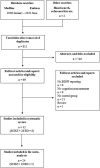Brain Derived Neurotrophic Factor and Cognitive Dysfunction in the Schizophrenia-Bipolar Spectrum: A Systematic Review and Meta-Analysis
- PMID: 35686181
- PMCID: PMC9170985
- DOI: 10.3389/fpsyt.2022.827322
Brain Derived Neurotrophic Factor and Cognitive Dysfunction in the Schizophrenia-Bipolar Spectrum: A Systematic Review and Meta-Analysis
Abstract
Background: Cognitive impairment is a core feature of disorders on the schizophrenia-bipolar spectrum, i.e., schizophrenia, bipolar disorder, and schizoaffective disorder. Brain-derived neurotrophic factor (BDNF) has been proposed to be a biomarker of cognitive impairment in these disorders as it plays a critical role in neuroplasticity and proposed to mediate some of the psychotropic effects of medication. However, despite numerous studies investigating the association between circulating BDNF and these disorders, no solid conclusions have been drawn regarding its involvement in cognitive impairment.
Objectives: The current systematic review and meta-analysis aims to examine blood BDNF levels and cognitive dysfunction in patients on the schizophrenia-bipolar spectrum as well as to evaluate whether circulating BDNF measurements can act as a biomarker for cognitive dysfunction.
Methods: Studies were identified by searching Embase and Medline databases for English language articles published in peer-reviewed journals between 2000 January and 2021 June according to the PRISMA guidelines. A total of 815 articles were identified of which 32 met the inclusion criteria for the systematic review - reporting on comparisons between blood BDNF levels and cognitive functions of schizophrenia or bipolar disorder patients versus healthy controls (no studies involving schizoaffective patients were specifically obtained for the time being). Twenty-four of these studies (19 with schizophrenia and 5 with bipolar disorder patients) were eligible to be included in the meta-analysis.
Results: Our findings indicated that circulating BDNF levels were significantly reduced in patients experiencing an acute episode of schizophrenia or bipolar disorder compared to healthy controls. Cognitive function was also found to be significantly worse in patients, however, correlations between BDNF levels and cognitive impairment were not always detected. Interventions, especially pharmacotherapy seemed to improve certain aspects of cognition and increase circulating BDNF levels.
Conclusion: Circulating BDNF alone does not seem to be a valid biomarker of cognitive dysfunction in patients with disorders on the schizophrenia-bipolar spectrum, owing to several confounding factors. Changes of the circulating levels of BDNF should be evaluated in a wider context of other stress-, immune-, and inflammatory-related factors.
Keywords: BDNF; biomarker; bipolar disorder; cognition; schizoaffective disorder; schizophrenia.
Copyright © 2022 Dombi, Szendi and Burnet.
Conflict of interest statement
ZD was an employee of Gedeon Richter Plc. The remaining authors declare that the research was conducted in the absence of any commercial or financial relationships that could be construed as a potential conflict of interest.
Figures




Similar articles
-
Peripheral inflammatory and neurotrophic biomarkers of cognitive impairment in schizophrenia: a meta-analysis.Psychol Med. 2019 Sep;49(12):1971-1979. doi: 10.1017/S0033291719001685. Epub 2019 Jul 9. Psychol Med. 2019. PMID: 31284882 Review.
-
Can Brain-Derived Neurotrophic Factor Be Considered a Biomarker for Bipolar Disorder? An Analysis of the Current Evidence.Brain Sci. 2023 Aug 20;13(8):1221. doi: 10.3390/brainsci13081221. Brain Sci. 2023. PMID: 37626577 Free PMC article. Review.
-
Brain-derived neurotrophic factor as a biomarker for cognitive recovery in acute schizophrenia: 12-week results from a prospective longitudinal study.Psychopharmacology (Berl). 2018 Apr;235(4):1191-1198. doi: 10.1007/s00213-018-4835-6. Epub 2018 Feb 1. Psychopharmacology (Berl). 2018. PMID: 29392373
-
The impact of BDNF Val66Met polymorphism on cognition in Bipolar Disorder: A review: Special Section on "Translational and Neuroscience Studies in Affective Disorders" Section Editor, Maria Nobile MD, PhD. This Section of JAD focuses on the relevance of translational and neuroscience studies in providing a better understanding of the neural basis of affective disorders. The main aim is to briefly summaries relevant research findings in clinical neuroscience with particular regards to specific innovative topics in mood and anxiety disorders.J Affect Disord. 2019 Jan 15;243:552-558. doi: 10.1016/j.jad.2018.07.054. Epub 2018 Jul 24. J Affect Disord. 2019. PMID: 30078664 Review.
-
Meta-analysis reveals no association of the Val66Met polymorphism of brain-derived neurotrophic factor with either schizophrenia or bipolar disorder.Psychiatr Genet. 2007 Jun;17(3):165-70. doi: 10.1097/YPG.0b013e32801da2e2. Psychiatr Genet. 2007. PMID: 17417060
Cited by
-
Converging Evidence Points to BDNF as Biomarker of Depressive Symptoms in Schizophrenia-Spectrum Disorders.Brain Sci. 2022 Dec 4;12(12):1666. doi: 10.3390/brainsci12121666. Brain Sci. 2022. PMID: 36552127 Free PMC article.
-
Brain-Derived Neurotrophic Factor (BDNF) as a Predictor of Treatment Response in Schizophrenia and Bipolar Disorder: A Systematic Review.Int J Mol Sci. 2024 Oct 18;25(20):11204. doi: 10.3390/ijms252011204. Int J Mol Sci. 2024. PMID: 39456983 Free PMC article.
-
Strategies for Achieving Better Cognitive Health in Individuals with Schizophrenia Spectrum: A Focus on the Canadian Landscape: Stratégies pour atteindre une meilleure santé cognitive chez les personnes souffrant du spectre de la schizophrénie : un regard sur le paysage canadien.Can J Psychiatry. 2025 Feb;70(2):85-97. doi: 10.1177/07067437241261928. Epub 2024 Jul 25. Can J Psychiatry. 2025. PMID: 39051555 Free PMC article. Review.
-
Fecal Microbiota Underlying the Coexistence of Schizophrenia and Multiple Sclerosis in Chinese Patients.Can J Infect Dis Med Microbiol. 2023 Aug 30;2023:5602401. doi: 10.1155/2023/5602401. eCollection 2023. Can J Infect Dis Med Microbiol. 2023. PMID: 37680457 Free PMC article.
-
Associations of BDNF/BDNF-AS SNPs with Depression, Schizophrenia, and Bipolar Disorder.J Pers Med. 2023 Sep 18;13(9):1395. doi: 10.3390/jpm13091395. J Pers Med. 2023. PMID: 37763162 Free PMC article. Review.
References
-
- American Psychiatric Association. American Psychiatric Association: Diagnostic and Statistical Manual of Mental Disorders. 5th ed. Arlington, TX: American Psychiatric Association; (2013).
-
- WHO. WHO | Schizophrenia. Geneva: WHO; (2018).
Publication types
LinkOut - more resources
Full Text Sources
Miscellaneous

